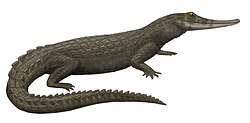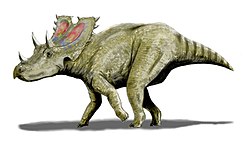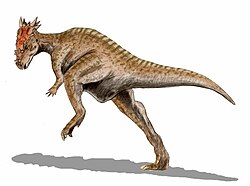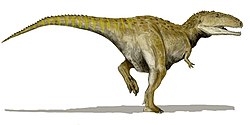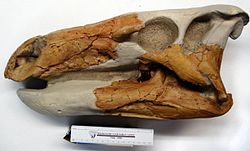| Name | Status | Novelty | Authors | Age | Unit | Location | Notes | Images |
|---|
Abdounornis marinus [62] | Nomen Nudum | Thesis name | Bourdon | Early Ypresian | | | A species of Charadriiformes, Abdounornithidae. | |
Aequornis traversei [62] | Nomen Nudum | Thesis name | Bourdon | Middle Eocene | | | A species of Pelagornithidae. | |
Anas cheuen [63] | Valid | Sp. nov. | Agnolín | Early or Middle Pleistocene | Miramar Formation | | A species of Anas . | |
Archaeorhynchus spathula [64] | Valid | Gen et Sp. nov. | Zhonghe & Fucheng | Early Cretaceous | Yixian Formation | | An Ornithurae, type sp A. spathula. | |
Branta thessaliensis [65] | Valid | Sp. nov. | Boev & Koufos | Middle Turolian | | | An Anatidae. | |
Cerebavis cenomanica [66] | Valid | Gen. et Sp. nov. | Kurochkin, Saveliev, Postnov,
Pervushov, & Popov | Cenomanian | | | An Enantiornithes, described from a brain endocast. | |
Corvitalusoides [67] | Valid | Gen. et Sp. nov. | Boles | Late Oligocene or Early Miocene | Riversleigh | | A Passeriformes Incertae Sedis.
Type species C. grandiculus | |
Cyanoliseus patagonopsis [68] | Valid | Sp. nov. | Hospitaleche & Tambussi | Pleistocene | Miramar Formation | | A Psittacidae. | |
Dalingheornis [69] | Valid | Gen. nov. et Sp. nov. | Zhang, Hou, Hasegawa, O'Connor, Martin, & Chiappe | Early Cretaceous | Yixian Formation | | An Enantiornithes, type species is Dal. liweii. | |
Dapingfangornis [70] | Valid | Gen. nov. et Sp. nov. | Li, Duan, Hu, Wang, Cheng, & Hou | Early Cretaceous | Jiufotang Formation | | An Enantiornithes, type species Dap. sentisorhinus | |
Didunculus placopedetes [71] | Valid | Sp. nov. | Steadman | Subrecent | 'Eua | | A Columbidae. | |
Ducula harrisoni [72] | Valid | Sp. nov. | Wragg & Worthy | Subrecent | Henderson Island | | A Columbidae. | |
Eclectus infectus [73] | Valid | Sp. nov. | Steadman | Holocene | 'Eua, 'Anatu | | A Psittacidae. | |
Gallirallus ernstmayri [74] | Valid | Sp. nov. | Jeremy J. Kirchman & Steadman | Holocene | New Ireland, Bismarck Archipelago | | A Rallidae. | |
Gallirallus pendiculentus [74] | Valid | Sp. nov. | Kirchman & Steadman | Holocene | Tinian | | A Rallidae. | |
Gallirallus pisonii [74] | Valid | Sp. nov. | Kirchman & Steadman | Holocene | Tinian | | A Rallidae. | |
Gallirallus storrsolsoni [75] | Valid | Sp. nov. | Kirchman & Steadman | Holocene | Huahine, Society Islands | | A Rallidae. | |
Gallirallus temptatus [74] | Valid | Sp. nov. | Kirchman & Steadman | Holocene | Rota | | A Rallidae. | |
Jungornis geraldmayri [76] | Valid | Sp. nov. | Mourer-Chauviré & Sigé | Late Eocene | Phosphorites du Quercy | | A Jungornithidae | |
Loxioides kikuchi [77] | Valid | Sp. nov. | James & Olson | Subrecent | Kauaʻi, Hawaii Islands | | A Fringillidae | |
Masillaraptor [78] | Valid | Gen. nov. et Sp. nov. | Mayr | Middle Eocene | Messel pit | | A Masillaraptoridae, type species M. parvunguis | |
Nyctanassa carcinocatactes [79] | Valid | Sp. nov. | Olson & Wingate | Holocene | Bermuda | | An Ardeidae. | |
Odontopteryx gigas [62] | Nomen Nudum | Thesis name | Bourdon | Early Ypresian | | | An Odontopterygidae | |
Odontoptila inexpectata [62] | Nomen Nudum | Thesis name | Bourdon | Early Ypresian | | | An Odontopterygidae | |
Pleistoanser [63] | Valid | Gen. et Sp. nov. | Agnolín | Early or Middle Pleistocene | Miramar Formation | | An Anatidae. Type species is P. bravardi. | |
Plesiocathartes major [80] | Valid | Sp. nov. | Weidig | Late Wasatchian | Green River Formation | | A Leptosomidae. | |
Plesiocathartes wyomingensis [80] | Valid | Sp. nov. | Weidig | Late Wasatchian | Green River Formation | | A Leptosomidae. |
Porphyrio mcnabi [75] | Valid | Sp. nov. | Kirchman & Steadman | Holocene | Huahine, Fa'ahia, Society Islands | | A Rallidae. | |
Pygoscelis calderensis [81] | Valid | Sp. nov. | Hospitaleche, Chávez, & Fritis | Late Miocene-Middle Pliocene | Bahia Inglesa Formation | | A Spheniscidae. | |
Pygoscelis grandis [82] | Valid | Sp. nov. | Walsh & Suárez | ?Early Pliocene | Bahia Inglesa Formation | | A Spheniscidae. | |
Shanxiornis [83] | Valid | Gen. et Sp. nov. | Wang, Zhao, Hu, & Sun | Early Pleistocene | Sanmen Formation | | A Phasianidae, type species is S. fenyinis | |
Tonniornis [84] | Valid | Gen. nov. et Sp. nov. | Tambussi, Hospitaleche, Reguero, & Marenssi | Late Eocene | La Meseta Formation | | A Spheniscidae, two species T. mesetaensis & T. minimum | |
Waimanu [85] | Valid | Gen. nov. et Sp. nov. | Slack, Jones, Ando, Harrison, Fordyce, Arnason, & Penny | Early Paleocene | Basic Waipara Greensand | | A stem Spheniscidae. The type species is Wa. manneringi. Originally the second species, Wa. tuatahi, was assigned to this genus as well; Mayr et al. (2018) transferred this species to the separate genus Muriwaimanu . [86] | |
Wieslochia [87] | Valid | Gen. et Sp. nov. | Mayr & Manegold | Rupelian | | | An early Passeriformes Incertae Sedis, type species is Wi. weissi | |












